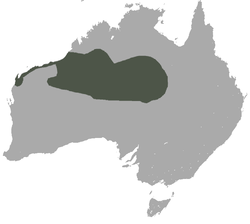| Lesser hairy-footed dunnart [1] | |
|---|---|
 | |
| Scientific classification | |
| Kingdom: | Animalia |
| Phylum: | Chordata |
| Class: | Mammalia |
| Infraclass: | Marsupialia |
| Order: | Dasyuromorphia |
| Family: | Dasyuridae |
| Genus: | Sminthopsis |
| Species: | S. youngsoni |
| Binomial name | |
| Sminthopsis youngsoni | |
 | |
| Lesser hairy-footed dunnart range | |
The lesser hairy-footed dunnart (Sminthopsis youngsoni) is a small carnivorous Australian marsupial of the family Dasyuridae. It is a widespread and fairly common species, being found in many desert areas of Western Australia, Northern Territory and Queensland. [3] Its foraging strategies have been studied by Haythornthwaite and Dickman. [4]
The lesser hairy-footed dunnart is distinguished from the very similar hairy-footed dunnart by its smaller size and less hairy soles. [3]
